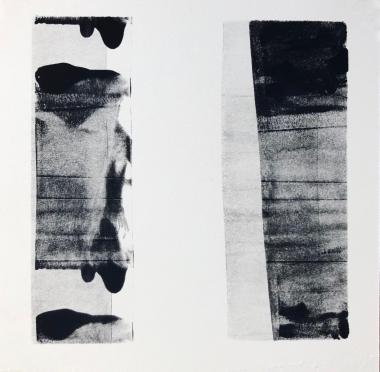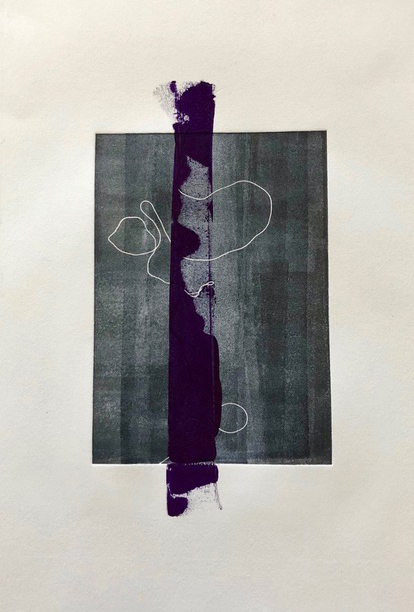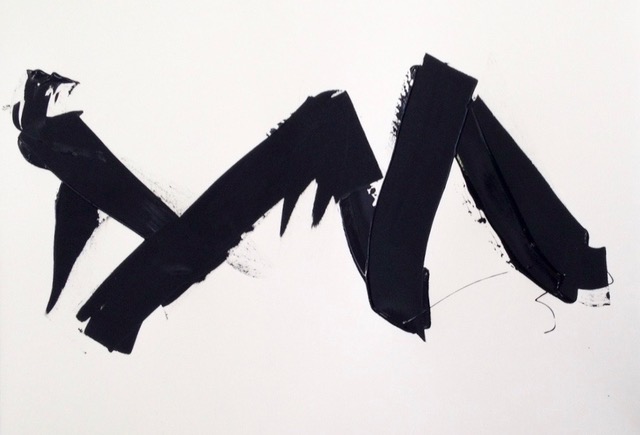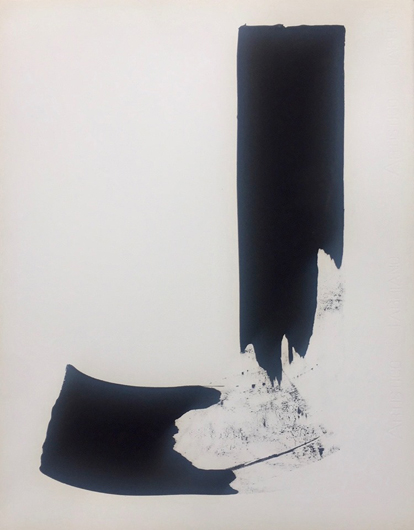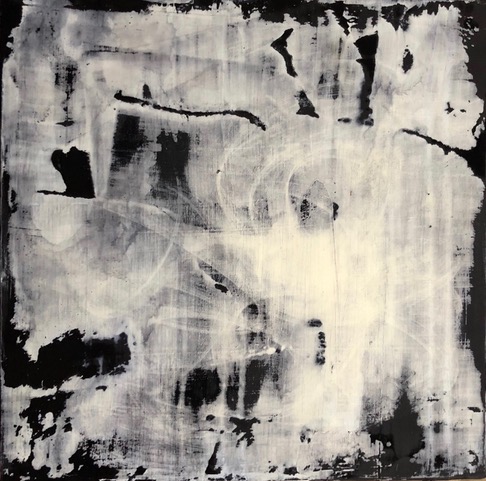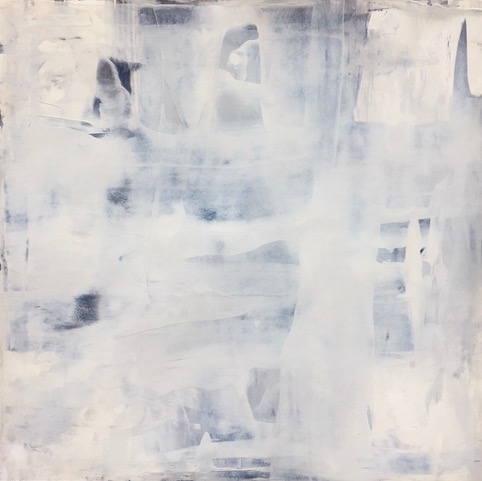Words, Pictures, Meaning
Lyn Horton
October 2019
The Writer Said:
Essence in the consideration of being, honestly, resides internally and triggers invention. It would take months to research the neuro-bio-psycho-babble of information in order to point to specific places in the brain that are chemically related to creation. Creation has a larger scope than the brain, though. Over there. Anywhere. Listen to all of it and smell all of it and taste all of it.
The Artist Said:
Making art is deeply personal. Each piece represents a moment, and channels part of myself that lacks conscious definition.
I work intuitively, organically, enjoying unintended consequences. I also work energetically, across many surfaces at once, without plan: printmaking and painting; mark making, scraping and sanding; adding, removing and layering paint.
Black is often prominent. Black embodies life most primal, for everything begins and ends in blackness. Celebrating black in its infinite gradation also celebrates the cycle of life.
The writer said:
What to do in time of grief. When some deep belief dies, when a beloved person dies or leaves a relationship? The response varies. How is it that an artist can handle it better than most? How is it that pain and despair migrate through images where they can be seen? Or to words, like these, which might point to other art forms?
The Artist said:
Life holds joy between birth & death; playfulness & color. Joy creates balance. Extraordinary moments of joy need not necessarily take a back seat to inevitable depths of sadness. There is dignity in knowing how one feels. Why one acts. And boundless dignity in creative expressions of both – in joy and sadness, challenges won or lost, expectations realized or shattered. The cycle of life has much to teach. And above all, it is a human purpose to learn.
The writer said:
How can faith constantly support daily depression, sadness, hopelessness? Faith is measured in pursuit of passion. Passion manifests the strengths of commitment to however life happens, whatever life does, whenever intuitive choices are made or unknowingly lost.
References to life become the songs of the birds. So many birdsongs. Through the open windows in the calm, in the peace of the still tree branches. Or through the breezes. The breezes blow to balance out the temperature of the air. In that transfer comes clarity. The hope to continue.
The artist said:
Sweeping horizontal gestures express freedom – personal freedom. Accepting stray marks along that path further accentuates the freedom to accept the random evolution of action in life. While one may seek to plan each moment, to control outcomes, accepting the impossibility of that concept brings even more freedom in creative expression – and in life.
The writer said:
The act of “becoming” imaginarily through art and image strips away the torrents of shock and disbelief in one kind of reality. A stratum of internal reality in art transcends the confusion and repression of emotions. The extensions of the self into art heals wounds, prevents incessant bashing and constant harassment emanating from the life out there, the one wants to avoid.
The artist said:
Rigidity interferes with authenticity. With actions detached from outcomes. The rigid vertical descends, but dissolves, knowing it’s unsustainable, but comforted by a horizontal footing, again allowing freedom of expression an unknown void. Indeed, one can argue easily in favor of the freedom to act, not control.
The writer said:
Suffering pain incites grabbing onto meaning even in the darkness. Tripping, falling, stumbling is part of finding the way. Blood will drip from the wounds of the struggle. Somehow, time and life’s miracle heal them.
Skin is punctured by injury. The tension of the skin is strong. In the healing, it renews strength of being. Meaning.
How dark can it be before the light shines through completely?
Emotional darkness is dense, gooey, entangled muck.
Emotional lightness comes with awareness.
The artist said:
Out of the darkness light. No matter how intensely darkened one’s days become, the light returns. Knowing darkness will transmute is of great comfort, even knowing the light may fade again. Change is our only constant in life; embracing change our only real anchor.
The writer said:
Manage.
In these paintings retrieve beauty. In that one stroke, evidence of one choice to scrape black or white or curl a single line as it drips from a brush across the surface. The unoccupied edges are more empty than the blackness or whiteness or a warm color could indicate.
It takes guts to say so little so many times. Ah, but, the essence. Retrieve the essence of being.
The artist said:
Sometimes, in spite of best efforts, there is a fog. Clarity will come, but sometimes with difficulty. The fog can hold exquisite beauty, a time of thoughtful contemplation, reassessment, and ultimately, a breakthrough. Can we learn to embrace the fog? Can we master hearing and following instinct? Even if not completely mastered, even if often uncomfortable, there’s acute value in listening. In the fog.
The writer said:
In prayer, in meditation, everything can be felt viscerally. The senses awaken. The body separates from the mind. The body vanishes. The purity of spirit lifts the weight of anguish and goes to the dimension that these paintings clutch.
The artist said:
Also, art is an antidote to worldly chaos. And I hope my work brings a small measure of peace to those who view it.
Paintings by Miriam Marshall
◊
Lyn Horton has been an artist for over forty years dedicated to maintaining a whole life experience now more than ever. She has a long history writing about creative improvised music for well-known publications, reviewing recordings, interviewing musicians and composing editorials. She has exhibited her art work extensively and is represented by the Cross MacKenzie Gallery outside of Washington, D.C. Horton was commissioned in 2012 to do a piece for the US Embassy in Vientiane, Laos. Her photography can be seen on Instagram.
Read other articles by Lyn Horton on Arteidolia→

